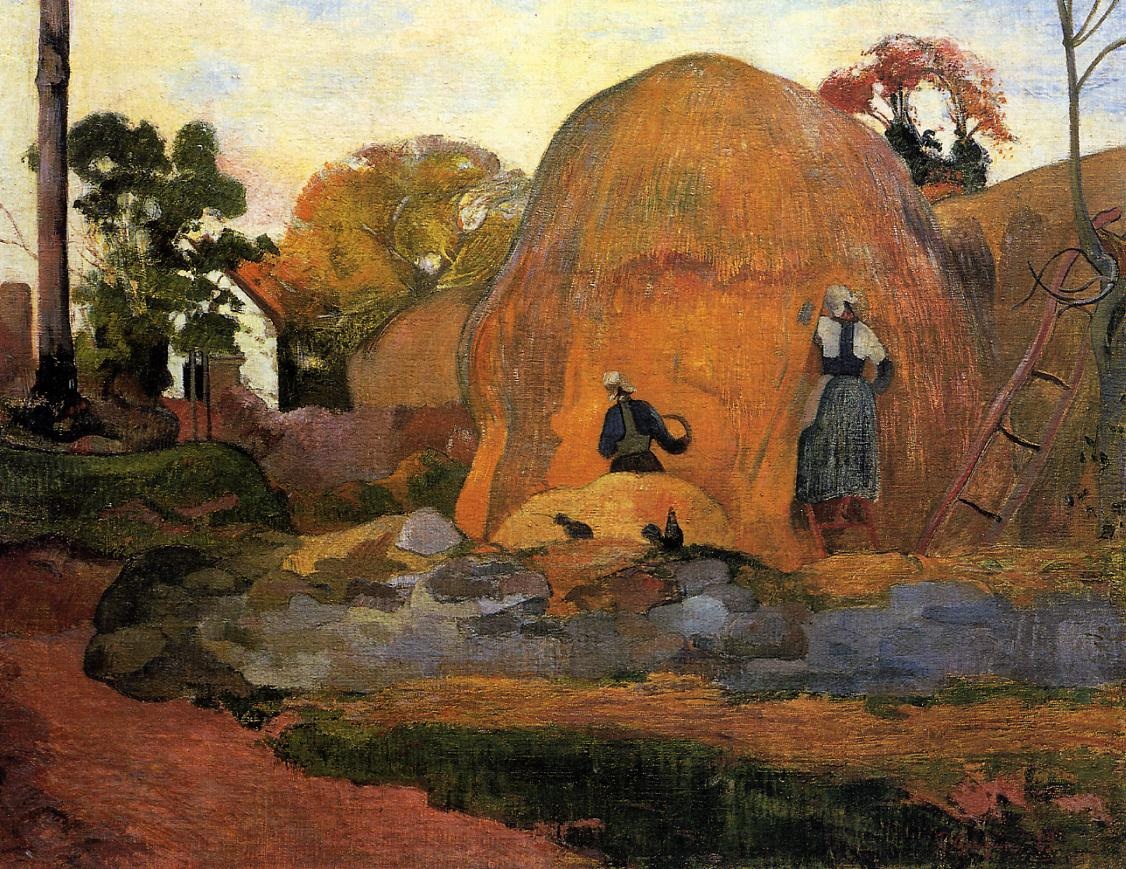Straw and hay are commonly cut and piled into windrows to dry before being packed up and removed from the field. Either may be baled into big blocks or cylinders for storage and distribution. Those bales wrapped tight in white plastic are actually silage, which can also be made by piling green vegetation into silos or trenches. This process preserves the material by fermentation, which maintains greater nutrient value than allowing it to dry.* In cold northern places like Upstate NY and parts of the Upper Midwest (where dairy is king), maize is often grown for silage. Silage maize is harvested whole before the grain is fully mature. This captures much of the energy of maize grain where seasons are not reliably long and warm enough to get the more valuable fully mature grain product.
Dry straw was removed from the outside of the stack each day for fresh animal bedding, opening up access to fresher vegetation within. The cows would continuously root out these inner layers, slowly transforming rounded stacks into (eventually unstable) mushroom shapes, while pigs and chickens kicked through the fallen debris looking for seeds. On cold and wet days, livestock would huddle under the ledges of these eroded stacks. A used up stack left a patch of extremely fertile composted soil in its place, which was apparently perfected for watermelons.
Haystacks shouldn't be confused with shocks (aka sheaves), which are small stacks of grain that has been cut but not threshed. Before combines, cutting grain with scythes was the first step of harvesting, followed by bringing in the sheaves and threshing and winnowing them. In pre-industrial times, the metals that were used to make scythes required constant sharpening in the field. I think this painting demonstrates how fun the use of such relatively primitive tools probably was.
At the end of last July, I watched the barley field by my apartment transformed to straw. A combine harvester combines cutting and cleaning the grain: reaping, threshing and winnowing. The most sophisticated (and incredibly expensive!) combine models can harvest huge amounts of grain, storing it in a bin and dropping finished bales of straw. In modern industrial ag, some farmers have left their own fields to become professional combine owner-operators, traveling throughout the U.S. grain belt, selling their services to farmers who can't afford to own and maintain their own combines.
 The grain was poured into some waiting trucks (spilling only a little). Straw was left behind in windrows (and presumably baled up later - but I left town before I saw it).
The grain was poured into some waiting trucks (spilling only a little). Straw was left behind in windrows (and presumably baled up later - but I left town before I saw it). Returning on the trail to my apt, this deer crashed by me on its way from one woods to another.
Returning on the trail to my apt, this deer crashed by me on its way from one woods to another.* One of the reasons those plastic wrapped bales have become popular is that you don't need to maintain a silo (or move the hay back and forth from it). I've heard that the fermentation process also increases the protein content of hay, but wikipedia seems to dispute this.
** Some more reading on how to grow your own hay
*** There's a real science to knowing what kind and richness of hay to feed animals at different times of the year to keep them healthy, but I don't know the details.
**** I know there's U.S. regional variation in the phrase "putting up hay" to refer to harvesting and storing hay, but I can't remember or find it now...



_by_WIlliam_Bliss_Baker.jpeg)



"Making hay" is the term I'm most familiar with.
ReplyDelete